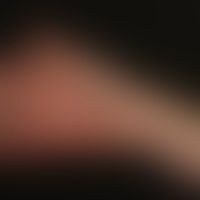Image diagnoses for "Macule"
325 results with 1215 images
Results forMacule

Argyria L81.8
argyria (detail): localized argyria of the lip region and the oral mucosa. at higher magnification, the irregular, dark metal deposits in the area of the red of the lips are clearly visible (circle). on "normal" lip skin, this color tone is not produced by the horny layer of the skin.

Klippel-trénaunay syndrome Q87.2
Klippel-Trénaunay syndrome: extensive vascular malformation with extensive nevus flammeus affecting the trunk and both legs. No evidence of soft tissue hypertrophies so far. No AV fistulas. Here detailed picture of the right hand.

Acrocyanosis I73.81; R23.0;
acrocyanosis. acute, changeable, homogeneously laminar, reddish-livid skin discoloration with reduced temperature. doughy swelling, hyperhidrosis, perniones and cutis marmorata. sometimes slight pain and dysesthesia.

Maculopapular cutaneous mastocytosis Q82.2
Urticaria pigmentosa: Generalized, macular, livid-red to brownish, partly confluent "exanthem-like" clinical picture on the trunk of a 41-year-old woman.

Teleangiectasia macularis eruptiva perstans Q82.2
Teleangiectasia macularis eruptiva perstans. 58-year-old patient with a generalized, flekc-shaped clinical picture which has existed for years and shows a constant progression. itching during sweat-inducing efforts and mechanical exposure of the affected skin areas. close-up with bizarre teleangiectatic vessel convolutions.

Vitiligo (overview) L80
Vitiligo: spots depigmented with varying degrees of intensity. vertical arrow above: focus in advanced uniform repigmentation. horizontal arrow: uniform but still incomplete repigmentation. vertical arrow below: new roundish focus in older already (incomplete) repigmented area.

Purpura thrombocytopenic M31.1; M69.61(Thrombozytopenie)
Purpura thrombocytopenic: Hemorrhagic spots with a tendency to confluence, existing on both lower legs with emphasis on the extensor sides. It is a drug-induced form of a thrombotic- thrombocytopenic purpura with hemolytic microangiopathic anemia and central nervous failure symptoms. The trigger was the ingestion of non-steroidal anti-inflammatory drugs. Sudden onset with fever, disorientation, stupor.

Mycosis fungoides C84.0
Mycosis fungoides: Plaque stage. 32-year-old male with multiple, disseminated, 1.0-5.0 cm large, moderately itchy, hardly consistency increased, red, rough plaques; clinically and histologically no detectable LK infection.

Dermatomyositis paraneoplastic M33.1

Nail hematoma T14.05
Hematoma, nail hematoma: clearly limited nail discoloration in all directions, see next figure with comparison after 8 weeks.

Erythronychia longitudinalis; L60.9 L60.8
Erythronychia, localized longitudinal detail magnified by reflected light microscopy; solitary, painless, red longitudinal striation of the nail plate with slight, V-shaped retraction and several splinter hemorrhages.

Nappes claires C84.4
Nappes claires: almost erythrodermic poicolodermatic form of Mycosis fungoides, splashes of light skin in the large mycotic plaques.

Purpura pigmentosa progressive L81.7
Purpura pigmentosa progressiva. discrete blurred red to red-brown spots. slight itching. occurs after taking ibuprofen due to a flu-like infection.

Amyloidosis systemic (overview) E85.9
AL-amyloidosis in smoldering myeloma. 77-year-old patient with recurrent ecchymosis of the periorbital region, clinically corresponding to a hematoma of the eyeglasses. These characteristic skin lesions are called "raccoon sign". Further purple skin lesions are found in the neck and retroauricularly. The bone marrow biopsy showed a smoldering myeloma (infiltration of plasma cells at 15%).

Mononucleosis infectious B27.9
mononuleosis, infectious. generalized (almost universal) macular exanthema. raspberry tongue with swollen papillae. tongue surface completely free of coating.









